A spontaneous low-pathogenic variant of Theiler's virus contains an amino acid substitution within the predominant VP1(233-250) T-cell epitope
- PMID: 9444995
- PMCID: PMC124573
- DOI: 10.1128/JVI.72.2.1020-1027.1998
A spontaneous low-pathogenic variant of Theiler's virus contains an amino acid substitution within the predominant VP1(233-250) T-cell epitope
Erratum in
- J Virol 1998 Aug;72(8):6965
Abstract
Theiler's murine encephalomyelitis virus (TMEV) induces immune-mediated demyelination after intracerebral inoculation of the virus into susceptible mouse strains. We isolated from a TMEV BeAn 8386 viral stock, a low-pathogenic variant which requires greater than a 10,000-fold increase in viral inoculation for the manifestation of detectable clinical signs. Intracerebral inoculation of this variant virus induced a strong, long-lasting, protective immunity from the demyelinating disease caused by pathogenic TMEV. The levels of antibodies to the whole virus as well as to the major linear epitopes were similar in mice infected with either the variant or wild-type virus. However, persistence of the variant virus in the central nervous system (CNS) of mice was significantly lower than that of the pathogenic virus. In addition, the T-cell response to the predominant VP1 (VP1(233-250)) epitope in mice infected with the variant virus was significantly weaker than that in mice infected with the parent virus, while similar T-cell responses were induced against another predominant epitope (VP2(74-86)). Further analyses indicated that a change of lysine to arginine at position 244 of VP1, which is the only amino acid difference in the P1 region, is responsible for such differential T-cell recognition. Thus, the difference in the T-cell reactivity to this VP1 region as well as the low level of viral persistence in the CNS may account for the low pathogenicity of this spontaneous variant virus.
Figures

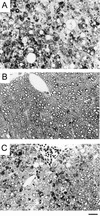
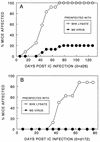
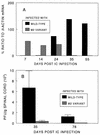
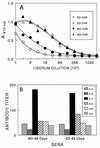
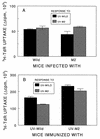
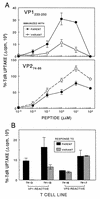

Similar articles
-
Preferential induction of IL-10 in APC correlates with a switch from Th1 to Th2 response following infection with a low pathogenic variant of Theiler's virus.J Immunol. 2002 Apr 15;168(8):4221-30. doi: 10.4049/jimmunol.168.8.4221. J Immunol. 2002. PMID: 11937584
-
A predominant viral epitope recognized by T cells from the periphery and demyelinating lesions of SJL/J mice infected with Theiler's virus is located within VP1(233-244).J Immunol. 1994 Nov 15;153(10):4508-19. J Immunol. 1994. PMID: 7525707
-
Class II-restricted T cell responses in Theiler's murine encephalomyelitis virus-induced demyelinating disease. V. Mapping of a dominant immunopathologic VP2 T cell epitope in susceptible SJL/J mice.J Immunol. 1994 Jan 15;152(2):908-18. J Immunol. 1994. PMID: 7904291
-
Multiple pathways to induction of virus-induced autoimmune demyelination: lessons from Theiler's virus infection.J Autoimmun. 2001 May;16(3):219-27. doi: 10.1006/jaut.2000.0489. J Autoimmun. 2001. PMID: 11334486 Review.
-
Molecular pathogenesis of Theiler's murine encephalomyelitis virus-induced demyelinating disease in mice.Intervirology. 1997;40(2-3):143-52. doi: 10.1159/000150541. Intervirology. 1997. PMID: 9450231 Review.
Cited by
-
Identification of a novel neuropathogenic Theiler's murine encephalomyelitis virus.J Virol. 2011 Jul;85(14):6893-905. doi: 10.1128/JVI.00274-11. Epub 2011 May 4. J Virol. 2011. PMID: 21543488 Free PMC article.
-
Anticapsid immunity level, not viral persistence level, correlates with the progression of Theiler's virus-induced demyelinating disease in viral P1-transgenic mice.J Virol. 2008 Jun;82(11):5606-17. doi: 10.1128/JVI.02442-07. Epub 2008 Mar 19. J Virol. 2008. PMID: 18353953 Free PMC article.
-
Capsid-specific cytotoxic T lymphocytes recognize three distinct H-2D(b)-restricted regions of the BeAn strain of Theiler's virus and exhibit different cytokine profiles.J Virol. 2002 Apr;76(7):3125-34. doi: 10.1128/jvi.76.7.3125-3134.2002. J Virol. 2002. PMID: 11884537 Free PMC article.
-
Theiler's virus infection induces a predominant pathogenic CD4+ T cell response to RNA polymerase in susceptible SJL/J mice.J Virol. 2009 Nov;83(21):10981-92. doi: 10.1128/JVI.01398-09. Epub 2009 Aug 12. J Virol. 2009. PMID: 19706717 Free PMC article.
-
The level of viral infection of antigen-presenting cells correlates with the level of development of Theiler's murine encephalomyelitis virus-induced demyelinating disease.J Virol. 2015 Feb;89(3):1867-78. doi: 10.1128/JVI.02471-14. Epub 2014 Nov 26. J Virol. 2015. PMID: 25428872 Free PMC article.
References
-
- Bae Y S, Yoon J W. Determination of diabetogenicity attributable to a single amino acid, Ala776, on the polyprotein of encephalomyocarditis virus. Diabetes. 1993;42:435–443. - PubMed
-
- Chen H H, Kong W P, Zhang L, Ward P L, Roos R P. A picornaviral protein synthesized out of frame with the polyprotein plays a key role in a virus-induced immune-mediated demyelinating disease. Nat Med. 1995;1:927–931. - PubMed
Publication types
MeSH terms
Substances
Associated data
- Actions
Grants and funding
LinkOut - more resources
Full Text Sources
Molecular Biology Databases

